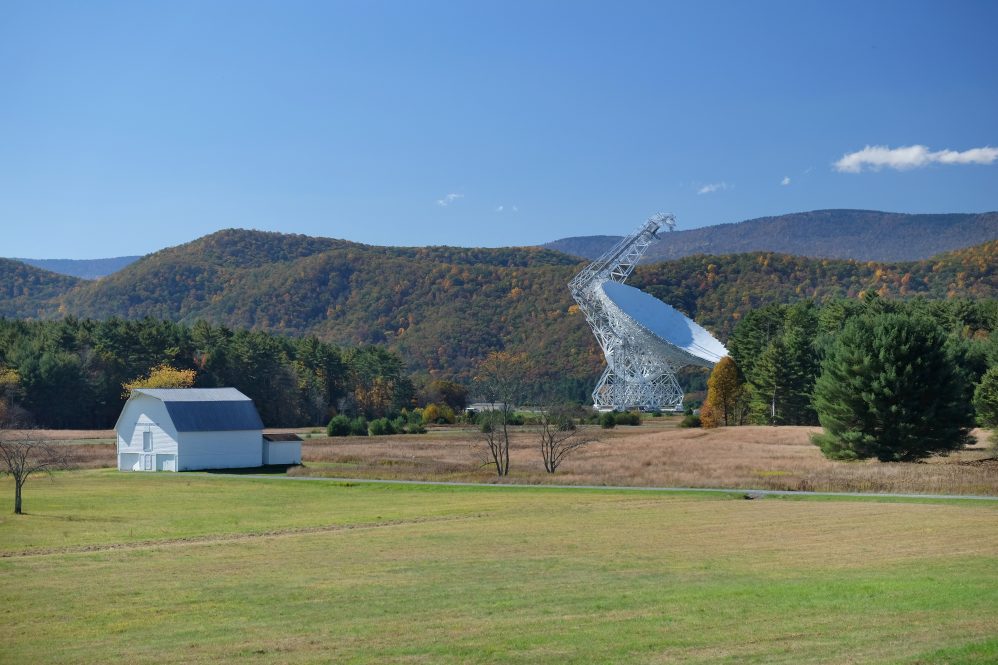The National Science Foundation (NSF) has renewed its support of the North American Nanohertz Observatory for Gravitational Waves (NANOGrav) with a $17 million grant over five years to operate the NANOGrav Physics Frontiers Center (PFC). UConn astrophysicist Chiara Mingarelli is one of the researchers comprising an international team hoping to address a transformational challenge in astrophysics: the detection and characterization of low-frequency gravitational waves.
“Detecting gravitational waves will open the next window of observation on the universe. These low frequency gravitational waves can come from supermassive black hole binaries, or cosmic strings, or can be signatures of inflation. It might be all three. With this grant, we hope to explore these possibilities and more,” says Mingarelli.
NANOGrav’s low-frequency gravitational-wave detectors are millisecond pulsars—rapidly spinning, superdense remains of massive stars that have exploded as supernovas. These ultra-stable stars are nature’s most precise celestial clocks, appearing to “tick” every time their beamed emissions sweep past the Earth, like the beacon on a lighthouse. Gravitational waves may be detected in the small but perceptible fluctuations—a few tens of nanoseconds over ten or more years—they cause in the measured arrival times at Earth of radio pulses from these millisecond pulsars.
“The NANOGrav PFC has made significant progress over the last five years, remaining at the frontier of fundamental physics research,” says Jim Shank, the program director for NSF’s PFC program. “The center now seems close to making a breakthrough discovery in gravitational waves and the way we perceive the universe.”
NANOGrav was founded in 2007 and at the time consisted of 17 members in the United States and Canada, it is now a highly distributed collaboration with around 200 students and scientists at about 40 institutions around the world. Over the past few years, NANOGrav PFC students, postdocs, and senior personnel have pushed the frontiers of multi-messenger astrophysics, achieved an unprecedented sensitivity to low-frequency gravitational waves, and enabled a transition into astrophysically interesting territory: NANOGrav is now poised to detect low-frequency gravitational waves and use them to study the universe in a completely new way.
Xavier Siemens, a physicist at Oregon State University, is the Principal Investigator (PI) for the project and will serve as Co-Director of the Center. Maura McLaughlin, an astronomer at West Virginia University and Co-Investigator of the project, will also serve as Co-Director.
The funding will enable Mingarelli and students to investigate the long-standing problem of how supermassive black holes merge.
“I am excited to get to work!” says Mingarelli, “Together with my team of students at UConn, we will investigate how supermassive black holes, a billion times the mass of our sun, merge. We will predict gravitational-wave signatures and also search the pulsar timing data for our predicted signals.”
NANOGrav’s five-year program will make use of the unique capabilities and sensitivity of the Green Bank Telescope (GBT) in Green Bank, West Virginia. The GBT is located in the National Radio Quiet Zone, which protects the incredibly sensitive telescope from unwanted radio interference, enabling it to study pulsars and other astronomical objects. It also uses data from the Very Large Array (VLA) in New Mexico and the Canadian Hydrogen Intensity Mapping Experiment (CHIME) in Canada. In addition, NANOGrav will use legacy Arecibo Observatory data which will anchor combined future data sets, and greatly increase our sensitivity. The GBT, VLA, and Arecibo are all funded by the National Science Foundation.
“Arecibo was an important part of NANOGrav, however, we we’ve had contingency plans for many years now, because it has slowly been decommissioned,” says Mingarelli. “While we do miss Arecibo as it was really important for precise pulsar timing, what we have right now is an amazing international network, which now includes colleagues in India, and we hope will soon include colleagues in China.”
NANOGrav’s ambitious science goals are accompanied by a comprehensive education and outreach program that involves students at all levels and specifically those who are traditionally under-represented in physics and astronomy,
Mingarelli says, “We are joining a large thriving and diverse community, full of opportunities for students to travel and learn from both peers and leaders in the field. With this grant we will continue our efforts with the Pulsar Search Collaboratory (PSC). This is a program where we go into high schools and teach students how to look for new pulsars in the radio data. A few pulsars have been found this way, so high school students have had their names on scientific publications before they even get to college. Outreach has always been really important to me and it is a great way for undergraduate physics students to gain outreach skills as well.”
To listen to Mingarelli talk more about the NANOGrav project, watch this short video, and another here, or read interviews linked through her webpage. For more information, please check NANOGrav’s website at: http://nanograv.org



